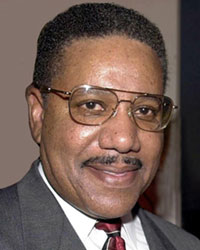This post has already been read 2015 times!
By JOHN PHILLIPS
Major General United States Air Force, ret
Deputy Under Secretary of Defense Logistics, fmr

General Phillips recently presented a keynote address to the One Network Enterprises team during the launch of the Value 4.0 campaign, an initiative to focus the entire company on delivering even greater value and financial performance to customers and their entire business network.
I am proud to say that I’ve served in four wars — Vietnam, Iraq, Bosnia, Afghanistan, and in 1979 I was taken hostage in Iran. But in all cases of warfighting, there are some common threads, strategy, and tactics. And there are some essential elements in strategy and tactics. Those essential elements are speed, range, flexibility, sustainability, survivability, and lethality.
The Department of Defense (DoD) is in the profession of arms, versus being in the profession of profit, but there are many commonalities in how wars are prosecuted and how industry executes its business.
- Speed, for instance, equates to time-to-market.
- Range equates to scalability in business.
- Flexibility equates to the changing market demands and changing requirements. How in battle the enemy’s activity and action are not wholly deterministic, so we’ve got to be flexible in order to accommodate the enemy’s maneuverability.
- Sustainability equates to product support and business continuity
- Lethality equates to defending the competitive challenges
- And Survivability equates to return on investment. What is your ROI and that’s all pursuant to the company’s growth and profitability.
Victory in battle is dependent upon several factors. A well-trained team. Intelligence about the enemy, and obviously your overwhelming superiority. The element of surprise. And the ability to shape the battlefield to influence the enemy. Shaping the battlefield really equates to the changing the requirements that you experience – shaping the customer’s requirements — the customer’s needs versus a customer’s wants.
The spectrum of conflict has three elements. First, you want to influence. Second, you want to deter. And third, you want to defeat the enemy. And you want to defeat the enemy with a swift and decisive victory with minimum loss of life and minimum expenditure of resources.

The underpinning of any successful battle requires strategies and tactics, techniques and procedures, something that we refer to as a POAM, a plan of action and milestones with measurable goals.
Each of our incursions had a codename, whether it was Desert Storm, Desert Shield, and in the case of Vietnam, it was Operation Linebacker. Each came with a vision, a mission, a goal, an objective, and a measurable outcome.
Many people would view these Campaigns as “flavor of the month” and “this too shall pass” – “we’ll wait it out.” But I would suggest to you that in the case of war, leadership is not a democracy. Can you imagine telling a young troop to charge that hill and some defiant young trooper says, “Well, sir, there’s somebody already on that hill!” Strong direction is required. I think that One Network’s Value 4.0 campaign is very timely, and it’s very appropriate. It’s not a flavor of the month, and it is very much needed in the industry.
The Constant Battle Against Bureaucracy
Because of the dynamic and ubiquitous nature of information technology, an organization must be in a state of constant disequilibrium. And that is not to be confused with chaos. Moore’s Law suggested some time ago that an IT revolution occurred every 18 months. I would suggest to you that revolution is now every 9 months. So, you must be in the state of disequilibrium – of constant change. If an organization ever reaches a state of equilibrium, your enemy (in the case of the DoD) will pass you by, and in the case of industry your competition will overtake you and will capture the market.
"Because of the dynamic and ubiquitous nature of information technology, an organization must be in a state of constant disequilibrium. If you ever reach a state of equilibrium, your competition will overtake you." – Gen. John Phillips (ret) Click To TweetThere is a lot of comfort in “routineity,” saying “it was good enough for my grandpa, and it was successful in the past…” But the Department of Defense cannot be caught fighting the last war, and industry cannot stagnate, admiring yesterday’s successes.
The DoD customer is steeped in tradition, and therefore steeped in inertia. When I was a political appointee as Deputy Under Secretary of Defense Logistics – which I thoroughly enjoyed, working with the Air Force, Army, Navy and Marine Corps – once I became a part of this bureaucracy, I used to describe it as “bureaucratic inertia.” A bureaucracy in equilibrium that sustained itself through para-mutual taskings, and a bureaucracy that would continue unperturbed even if acted on by an outside force. And even if the customer died, the bureaucracy would continue if in fact it even recognized that the customer was there or not!
If you’ve ever dealt with the Pentagon and this massive bureaucracy, it can be very frustrating. Notwithstanding that, there is a way to penetrate it. In fact, when I was with Honeywell, I wrote a book called “Navigating the Pentagon” which was never published except internally, because they thought it might advantage the competitor. But it addresses all of these issues in terms of dealing with this massive bureaucracy.
The Two Cultures: Defense vs Commercial
There really are two different cultures – there’s a culture of DoD, and there’s the commercial culture. Let me give you some examples of how these two cultures differ.
- DoD is in the profession of arms. The commercial world is in the profession of profit.
- DoD uses taxpayer funds. Industry uses investor funds.
- The forcing function in DoD is what I refer to as the “tyranny of Congress.” In industry, it’s the “tyranny of Wall Street.”
- We are driven by warfighter demands. In industry, it’s quarterly returns – “Gotta make your numbers.”
- Our metric is return of lives. The commercial metric is return on investment. And because of this notion of return of lives, it leads the Department of Defense to do a lot of “overspec-ing.” That’s part of the frustration that you experience when you’re dealing with DoD, because industry does not have to worry about return of lives, but the Department of Defense will overspec, because a life-threatening consequence is unacceptable. Therefore, you will be drilled and drilled and drilled for specs.
- With Department of Defense, taxpayer dollars require full and open competition in accordance with federal acquisition regulations. Industry is not so regulated, and that’s a good thing.
Now, some view the profit motive with suspicion, and in fact, I used to think of contractors as low life, blood-sucking, bottom-feeding scoundrels! Once I became a part of industry, I recognized how caring, compassionate, and intellectually astute we really are!
Laden with Legacy Systems
There are clearly some challenges in dealing with the DoD customer, and many of you have worked with them for years, but full and open competition is very time consuming. And then there’s the power of incumbency, which is real. You know, you get comfortable with a particular contractor, then you tend to want to go back to them.
And there is a tremendous installed base in the Department of Defense, and removing and replacing that installed base is really not an option. You’ve got to embrace and enhance, and that’s the strength of the One Network solution. I recognized that some years ago, and that’s a big seller in the Department of Defense.
"There is a tremendous installed base in the Department of Defense, and removing and replacing it is really not an option. You've got to embrace and enhance, and that's the strength of the One Network solution." – Gen. John Phillips (ret) Click To TweetThere’s a large and heterogeneous environment. There are islands of automation, so it’s an archipelago of systems. And there can be little documentation of bridging code to say what’s going to break when you shut off a system. Behind each of those systems is a proud owner. And they do not view it as legacy. They view them as operational systems. And then of course harmonizing naming conventions across this environment. You know, God was able to create the world in seven days because he didn’t have to deal with legacy!
Defense Organizations Are Making Progress!
One Network Enterprises has demonstrated the technical excellence to overcome these challenges, and has been very successful. I commend them and the engineering staff who worked behind the scenes to make that happen. Congratulations to all at One Network on your recent awards by the U.S. Air Force and the U.S. Navy (NOSS) in highly competitive selection processes.
A part of the art of war is the use of coalition forces. Now we do have a global economy. Therefore, we have a global footprint. And therefore, we have a global supply chain. We long recognized in the Department of Defense that supply chain interdiction is a proven technique in defeating the enemy.
Some years ago, I briefed a congressional committee on China’s control of rare earth elements. They are so critical to Department of Defense and to industry, included in such things as microchips, actuator motors, magnets, polished mirrors, battery technology. I titled the briefing “China’s Non-Kinetic War.” China produces 95% of the rare earth elements in the world. Now we do have rare earth elements here, we stopped producing them some time ago because of the environmental concerns, although we are now starting that industry back up. I suggested to Congress that they should designate Defense Logistics Agency as a strategic metal stockpile. Should China decide that they would want to stop producing rare earth elements, we would be vulnerable (and in fact, about eight years ago, there was an event that caused them to stop exporting rare earth elements and we recognized just how vulnerable we were.)
The key here is to make sure that you know your supply chain, and that is the entire supply chain of custody — that is critically important.
Each of you must assume ownership of Value 4.0. Troops in battle are singularly focused on the mission and each of you is a branding agent. Each soldier is focused on winning and surviving as a team. But after winning the battle, you must not lose the war. You must also win the peace. In business, winning the contract is step one. Delivering and supporting the product is the final act.
As I have studied Value 4.0, I really think that you’ve got the blueprint for a very successful campaign to expand customer value, but you must internalize it and execute it. It is your duty. It is your honor. It is your company.
Thank you.
You might also like…
Recommended Posts
- What is a Digital Supply Chain Network?
- Infographic: 6 Requirements for Transforming Supply Chains with Artificial Intelligence
- Generative AI: Force Multiplier for Autonomous Supply Chain Management
- How AI Will Transform Project Delivery in Advanced Manufacturing
- How Autonomous Vehicles Will Transform Last-Mile Delivery
- Infographic: 6 Requirements for Transforming Supply Chains with Artificial Intelligence - June 10, 2024
- Supply Chain Trends to Watch - March 13, 2024
- The Supply Chain Control Tower Quiz - August 8, 2023
